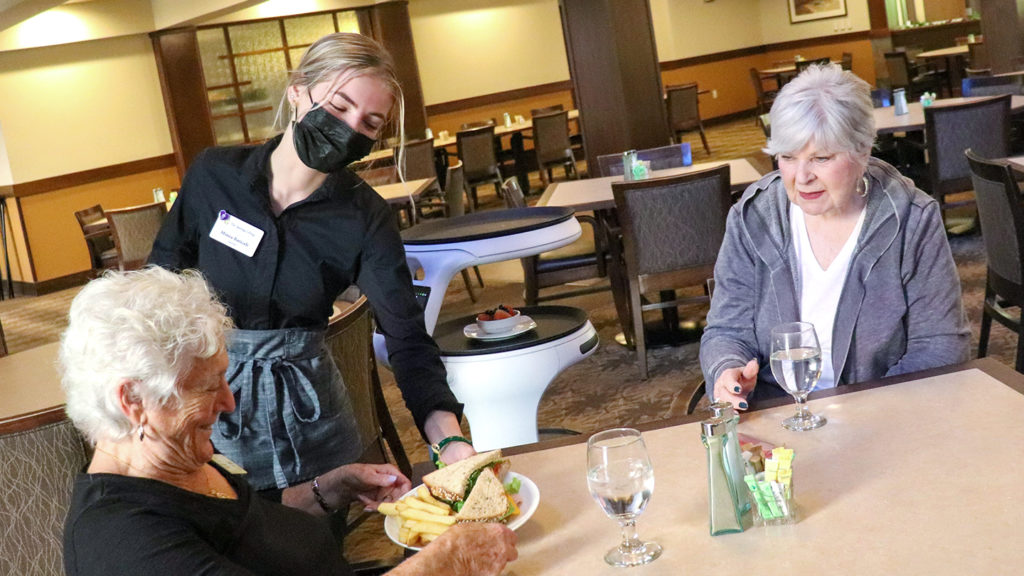
Staffing challenges got you down? Robotics may help, according to panelists speaking Wednesday at the virtual LeadingAge Collaborative Care Tech Summit 2022. They shared how they are using robotics applications in senior living and other areas of long-term care to supplement, support and enhance their workforces while also driving efficiencies.
Two years ago, Direct Supply Innovation and Technology Manager Justin Smith said, customer priorities centered around falls prevention and medication management, but the pandemic changed that narrative and bumped infection control and staffing to the top of the priority list.
Smith said his company is winnowing down a list of 70-plus robotics solutions to the ones that have the best potential effects for the industry.
“The way to think about robotics is to think about the tasks they are taking on,” he said. “Think about the tasks you spend time on that are not adding value and how to wipe those out.”
Army Distaff Foundation Vice President of Development and Strategic Operations James Michels, whose company owns and operates Knollwood, a life plan community in Washington, D.C., said his community has focused efforts on two areas of robotics: social assistive robotic devices and exoskeleton rehabilitative therapy.
Knollwood partnered with Trinity College for three years to design and develop a socially assistive robot to provide brain training, bingo, music and other forms of cognitive therapy for its residents. The key to success, he said, was involving caregivers and residents in identifying not only the problem but also the solution.
“The end result was robotics developed by the people benefiting from it at the end, either the caregivers or the residents,” Michels said.
Similarly, the exoskeleton rehabilitative therapy — a bionic suit, of sorts — was implemented to address the needs of a resident who had a series of strokes, lost mobility and became depressed. A staff member who had used the suit as part of his therapy program in the military suggested using the technology to help that resident rebuild muscle movement and coordination and increase strength, capacity and gait motion.
“The resident loved it,” he said, adding that 10% of the life plan community’s residents have used the suit in its physical therapy program. “It gave her a new lease on life,” Michels said.
Cypress Living Vice President of Innovation Joe Velderman said that the company’s Cypress Cove community in Florida adopted the use of Servi robots in its dining rooms from Bear Robotics, re-engineering its frontline culinary department positions for servers and bussers. The robots work as food runners, freeing up employees to take on more tables and spend more time with residents.
The robots, Velderman said, created an operational savings, reducing by 330 hours per week the tasks of front house culinary services employees. The community reinvested the savings back into staffing in the form of increased wages.
“You’re not going to be able to completely replace people, nor do you completely want to replace people,” he said. “This is giving people the tools and technology to focus on what’s important in their role — working at the top of their credentials, doing what they prefer to be doing and not worry about mundane tasks.”
Velderman said the continuing care retirement community now is looking at ways to leverage robotic technology to augment package deliveries throughout campus.
Robotic process automation
During another panel discussion at Wednesday’s event, speakers discussed driving efficiencies through data analytics and soft robotic process automation, or RPA.
In much the same way that physical robots augment staffing, RPA tools can reduce or eliminate manual, repetitive processes in human resources, compliance, audits, contact tracing and survey support, among other uses.
United Methodist Communities Chief Information Officer Travis Gleinig said that UMC built a custom app and integrated it with its human resources software to automate approval processes, changes, employment terminations, schedule changes and other tasks previously performed on paper. The organization also rolled it into recruiting and onboarding to streamline the hiring process.
“It has downstream benefits for resident care and how communities are staffed and operated,” Gleinig said.
HumanGood Vice President of Information Technology Services / Advanced Data Analytics Tim Jones called data a “pot of gold” that providers can use to become more operationally efficient.
“We’re focused on a digital transformation — smart operations using data analytics,” Jones said, adding that RPA can take on tedious tasks and let employees focus on residents and relationship-building rather than on spreadsheets and number-crunching.




